The Victoria and Albert Museum in London has an exhibition on Contemporary South African Photography. Given my unwavering admiration for South African artists, it should have been a feast. And at times, it was. But the show is also immensely frustrating. The quality of works presented is unequal (who wouldn’t look like the ugly duckling when presented right next to a Guy Tillim or a David Goldblatt anyway?) and i often felt that the show lacked in depth. I don’t want one Hyena Man next to a Wild Honey Collector. I want a series of Hyena Men and then a series of Wild Honey Collectors. That’s how greedy i am but i also happen to think that you might not necessarily get a better sense of an artist’s work by picking up only one example of each series they have been working on.
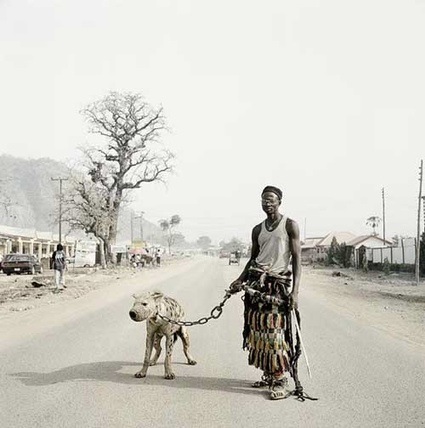 Pieter Hugo, Mallam Galadima Ahmadu with Jamis, Abuja, Nigeria 2005
Pieter Hugo, Mallam Galadima Ahmadu with Jamis, Abuja, Nigeria 2005
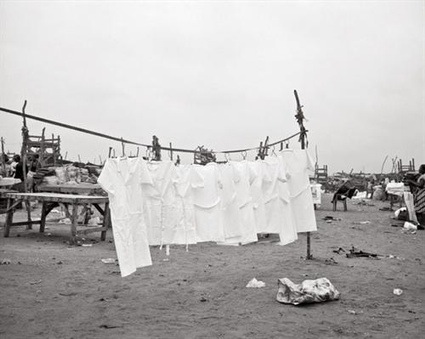 Jo Ractliffe, Schoolgirls’ uniforms, Roque Santeiro market 2007
Jo Ractliffe, Schoolgirls’ uniforms, Roque Santeiro market 2007
I had always wondered what made photography (and other forms of contemporary art) from South Africa so compelling. The introduction for the exhibition brings a series of answers to my question:
The excitement and urgency surrounding photography in South Africa today is partly explained by its local context: embedded in colonial history, ethnography, anthropology, journalism and political activism, the best photography emerging from the country has absorbed and grapples with its weighty history, questioning, manipulating and revivifying its visual codes and blending them with contemporary concerns. Post-Apartheid, complex and fundamental issues – race, society, gender, identity – remain very much on the surface. This is reflected by image makers who harness the resulting scenes as a form of creative tension within their personal vision. Here, distinctive photographic voices have emerged: local in character and subject matter, but of wider international interest because of their combined intensity.
Photography from South Africa comes with a heavy luggage. Long before it played its documentary part in the fight against apartheid, the medium was used as an instrument to classify people according to racial type. A few years after the fall of the apartheid, a new generation of artists and photo reporters is attempting to rebuild the picture of a country where the old rules of codes and structures governed by race have (somehow) started to crumble. A number of these photographers, however, have chosen to turn their back on the culture of realism that defined South African photography in the years of the fight against the segregation and are exploring a more purely artistic aspect of photography.
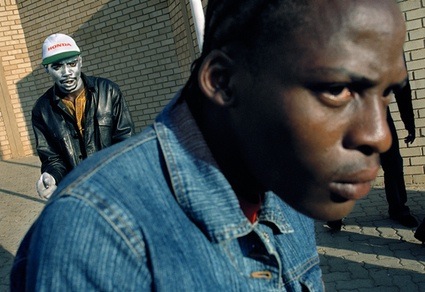 Graeme Williams, Soweto, from the Edge of Town series, 2006
Graeme Williams, Soweto, from the Edge of Town series, 2006
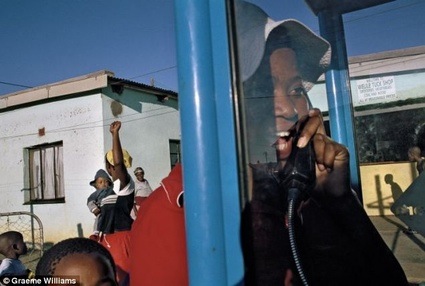 Graeme Williams, Springfontein, South Africa, from the Edge of Town series, 2006
Graeme Williams, Springfontein, South Africa, from the Edge of Town series, 2006
I knew a few of the artists in the show before entering the rooms but i did discover the fantastic work of Graeme Williams. The Edge of Town is the result of Williams’ trips to over 100 towns and townships around South Africa. Williams used to be a news agency photographer. The arrival of the new democracy left him confused as he explained in an interview: ‘Post-1994, you didn’t have apartheid lurking over your head, which meant no starting point for all the work I did. It was disconcerting.’
He had to look for a new language and moved from documentary to street photography, trying to convey moods and moments rather than facts and events. Williams worked only in early morning and evening light to create the long shadows and vibrant colours. As he has noted: ‘I wanted viewers to be slightly unsure of what was going on in each photograph and this reflects how I felt about change in South Africa at the time.’
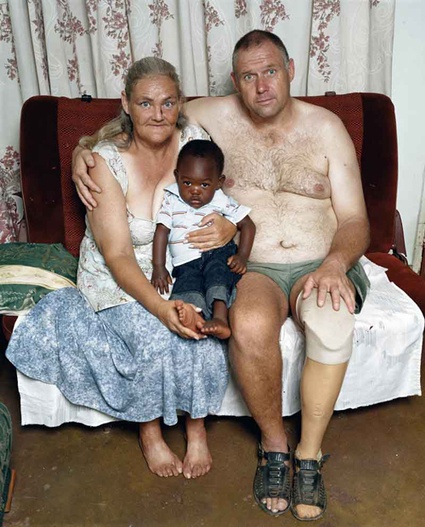 Pieter Hugo, Pieter and Maryna Vermeulen with Timana Phosiwa
Pieter Hugo, Pieter and Maryna Vermeulen with Timana Phosiwa
The photograph that opens the show at the V&A is part of Pieter Hugo‘s Messina/Musina, a set that raises questions about race and the nature of the family. This photo was shot in a rundown rented room in Blikkiesdorp, an area once populated by white railway workers. The white poor can no longer afford to buy land there and middle-class black families have taken their place in the neighbourhood. The white couple in the photograph rent a room from the child’s father.
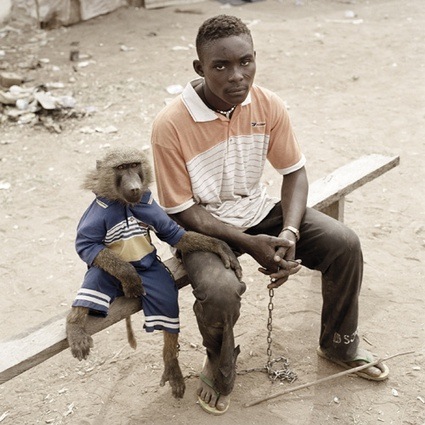 Pieter Hugo, Dayaba Usman with the monkey Clear, Abuja, Nigeria, 2005
Pieter Hugo, Dayaba Usman with the monkey Clear, Abuja, Nigeria, 2005
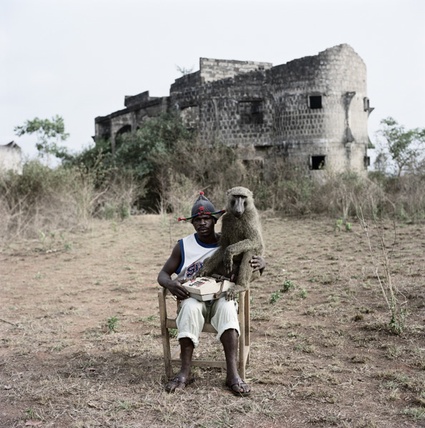 Pieter Hugo, Abdullahi Ahmadu with Emeka, Ibusa, Nigeria 2007
Pieter Hugo, Abdullahi Ahmadu with Emeka, Ibusa, Nigeria 2007
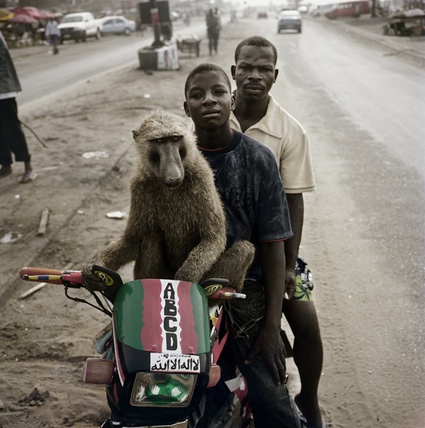 Pieter Hugo, Emeka, motorcyclist and Abdullahi Ahmadu, Asaba, Nigeria 2007
Pieter Hugo, Emeka, motorcyclist and Abdullahi Ahmadu, Asaba, Nigeria 2007
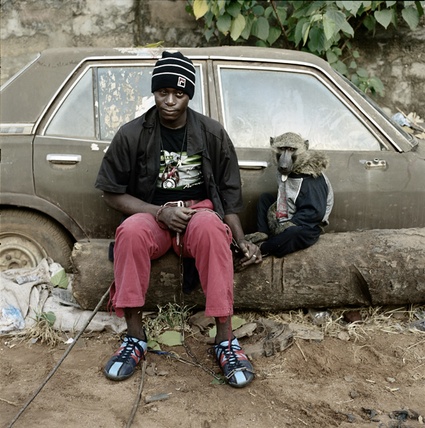 Pieter Hugo, Abu Kikan with Ajasco, Asaba, Nigeria 2007
Pieter Hugo, Abu Kikan with Ajasco, Asaba, Nigeria 2007
The show has also an image from the Wild Honey Collectors, another one from Permanent Error and one from The Hyena and Other Men, a series which i suspect many of you are familiar with. I’m obsessed with The Hyena and Other Men. I’d love to be able to buy Dayaba Usman with the monkey Clear but then the price a print fetched at a recent auction made me realize this will have to be for another life. To add insult to injury, the book The Hyena and Other Men is now out of print. How can it be out of print?!
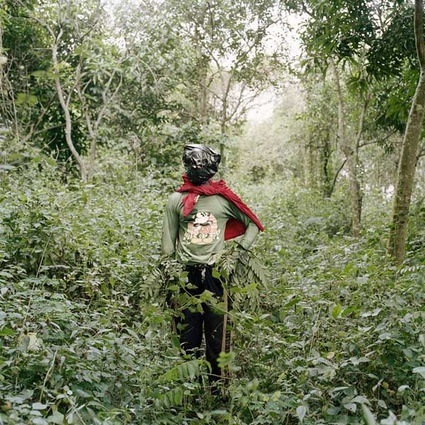 Pieter Hugo, Kwadwo Konado, Wild Honey Collector, Techiman District, Ghana, 2005
Pieter Hugo, Kwadwo Konado, Wild Honey Collector, Techiman District, Ghana, 2005
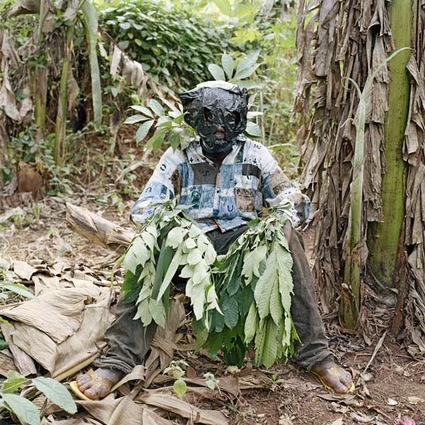 Pieter Hugo, Steven Amoako, Wild Honey Collector, Techiman District, Ghana, 2005
Pieter Hugo, Steven Amoako, Wild Honey Collector, Techiman District, Ghana, 2005
‘If one looks at the “Permanent Error” series, and “The Hyena and Other Men” and The Honey Collectors, one of the themes that keeps coming through is the issue of power and submission and domination. Whether it’s to do with the geopolitics between the first and so called third world, whether it’s man and animal with “Hyenas”, or man and environment with “Honey Collectors”.’
Pieter Hugo, interviewed by Tamar Garb, South Africa, 2010
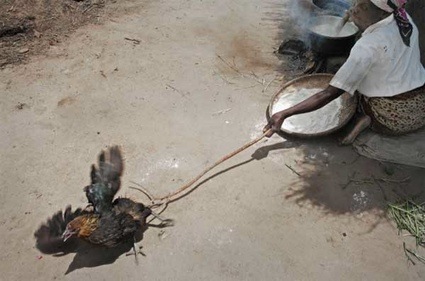 Guy Tillim, Petros Village, Malawi, 2006
Guy Tillim, Petros Village, Malawi, 2006
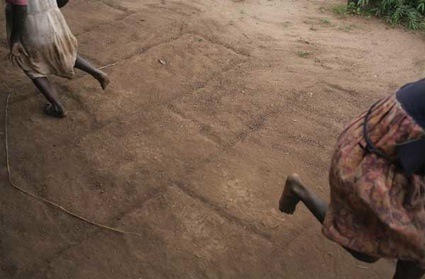 Guy Tillim, Petros Village, Malawi, 2006
Guy Tillim, Petros Village, Malawi, 2006
The intimate, oblique snapshots of everyday life that Guy Tillim shot in Petros Village, Malawi are miles apart from his photos of of African post-colonial architecture, Avenue Patrice Lumumba.
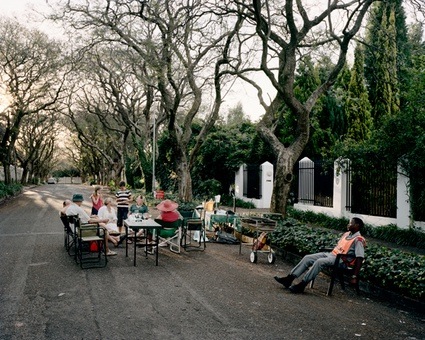 Mikhael Subotzky, Street Party, Saxonwold (from the series Security), 2008
Mikhael Subotzky, Street Party, Saxonwold (from the series Security), 2008
Mikhael Subotzky is another photographer whose work i’ve been admiring for a few years. More precisely since i saw the moving pictures he had taken in South African prisons. His recent work focuses on crime, violence and their inevitable accomplice: the quest for the ultimate security.
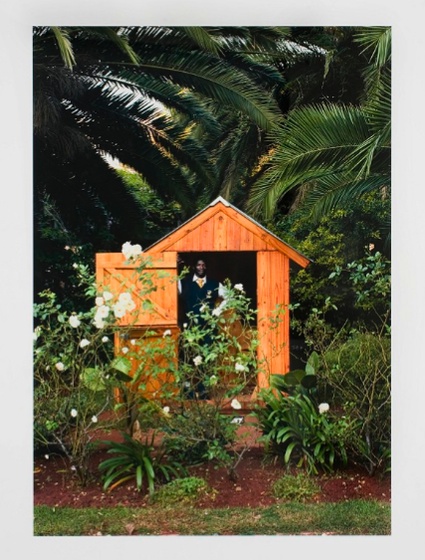 Mikhael Subotzky, Wendy House II, 2009
Mikhael Subotzky, Wendy House II, 2009
His series Security looks at the guards employed for protection by the middle and upper classes in wealthy districts of Johannesburg. Many of them survey the properties of their employers from the ‘Wendy houses’, wooden huts often found outside the mansions of South Africa’s predominantly white elite. ‘These “Wendy’s” or “Zozo’s” as they are known are simple in design, just as a child would draw the most essential of houses. They are also one of the few direct visual manifestations of the fear that is implicit in the surroundings.’
Mikhael Subotzky, 2010
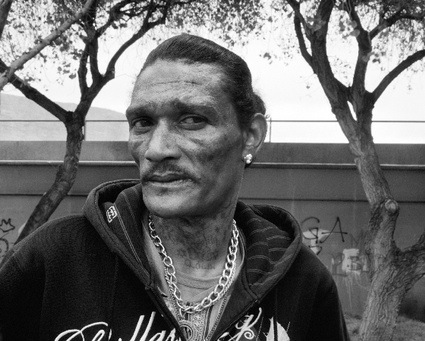 David Goldblatt, Blitz Maaneveld (from the Ex-Offenders series), 2008
David Goldblatt, Blitz Maaneveld (from the Ex-Offenders series), 2008
David Goldblatt has photographed South Africa since the late 1940s, observing its social, cultural and economic divides. He too had a few series showing at the V&A. For Ex-Offenders, he asked former criminals to go back to the scenes of the crimes that led to their incarceration and tell him their story.
Tradesmen are workers photographed at their work-places next to the hand-painted signs advertising their services. Unfortunately, I couldn’t find any image of this series online. ‘In post-Apartheid South Africa I became acutely aware that little signs were mushrooming on our sidewalks and on our trees and poles advertising all kinds of services: painting, building, tilling, carpentry. Often these were very crude but there was no question of what was happening. Suddenly black people were able and willing to offer their services within the suburban life of Johannesburg in ways that were not only [previously] unknown but forbidden because black people were not allowed to trade within white group areas.’
David Goldblatt, interviewed by Tamar Garb, South Africa, 2010
If you visit Figures & Fictions, don’t miss the exhibition of the photos that Goldblatt took at the time of the Apartheid. You can find it in the V&A Photography Gallery, room 38A.
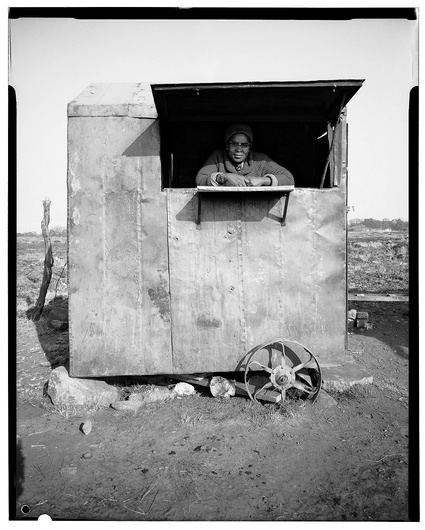 David Goldblatt, Cafe-de-Move-On, Croesus, 1964
David Goldblatt, Cafe-de-Move-On, Croesus, 1964
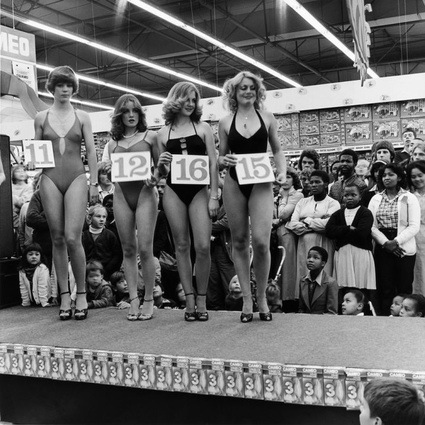 David Goldblatt, Miss Lovely Legs competition at the Pick ‘n Pay hypermarket, Boksburg
David Goldblatt, Miss Lovely Legs competition at the Pick ‘n Pay hypermarket, Boksburg
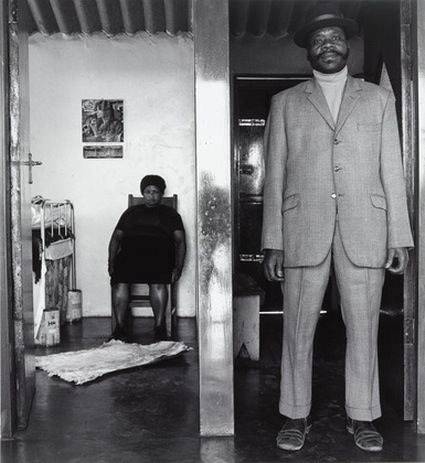 David Goldblatt, Couple in their House, Soweto, South Africa, 1972
David Goldblatt, Couple in their House, Soweto, South Africa, 1972
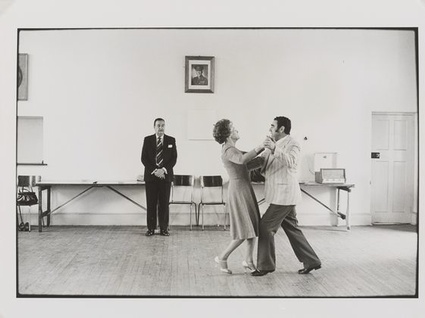 Dancing-master Ted van Rensburg watches two of his ballroom pupils swinging to a recording of Victor Sylvester and his Orchestra, at the Old Court House. Boksburg, 1980 From the series In Boksburg
Dancing-master Ted van Rensburg watches two of his ballroom pupils swinging to a recording of Victor Sylvester and his Orchestra, at the Old Court House. Boksburg, 1980 From the series In Boksburg
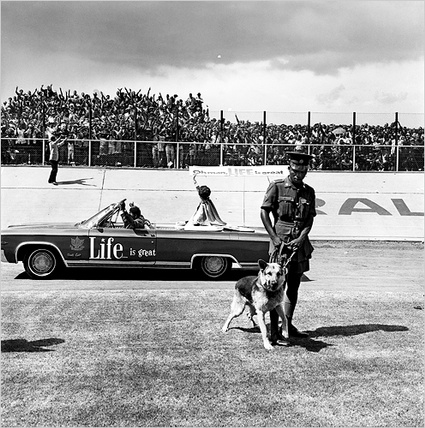 At the Soccer Cup Final. Orlando Stadium, Soweto, November 1972
At the Soccer Cup Final. Orlando Stadium, Soweto, November 1972
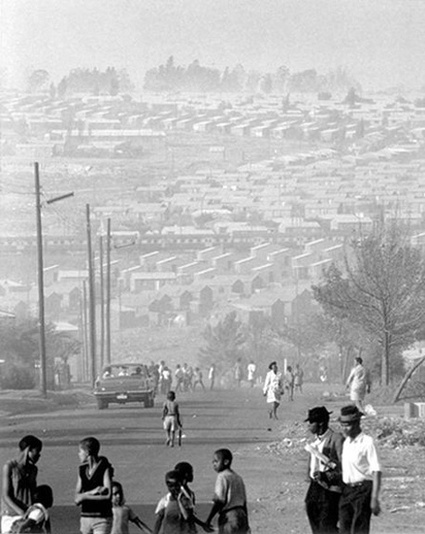 David Goldblatt, Mofolo South, Soweto 1972
David Goldblatt, Mofolo South, Soweto 1972
Figures & Fictions: Contemporary South African Photography features the work of 17 artists. Here’s a couple more i found fairly interesting:
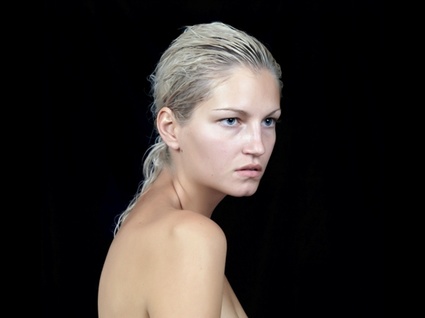 Roelof Petrus van Wyk, from the series Young Afrikaners – A Self Portrait, courtesy of the artist
Roelof Petrus van Wyk, from the series Young Afrikaners – A Self Portrait, courtesy of the artist
Roelof Van Wyk’s series Young Afrikaner – A Self Portrait echoes early ethnographic photography projects that portrayed black people as anonymous examples of ‘types’. series, Young Afrikaner – A Self Portrait. But whites people are now the ‘others’.
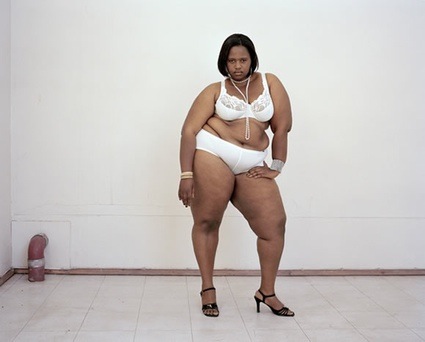 Jodi Bieber, ‘Babalwa’, (from the series Real Beauty), 2008
Jodi Bieber, ‘Babalwa’, (from the series Real Beauty), 2008
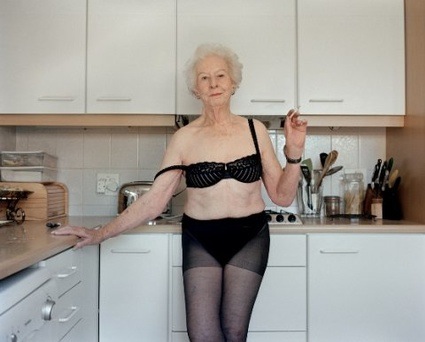 Jodi Bieber, from the series Real Beauty, 2008
Jodi Bieber, from the series Real Beauty, 2008
Photojournalist Jodi Bieber -who won a major award for her Time cover of an Afghan woman whose nose had been cut off by the Taliban- is showing a photo series inspired by the Dove campaigns that used ‘real’ women to advertise their soaps and creams. In Real Beauty, women of all sizes are posing in their underwear. The series denounces the influence of Western media and culture in South Africa on ideals of female body shape. Their impact is so strong that cases of black anorexic women is increasing in the country, as the full figured body which was once celebrated is no longer as desirable as Western body shapes.
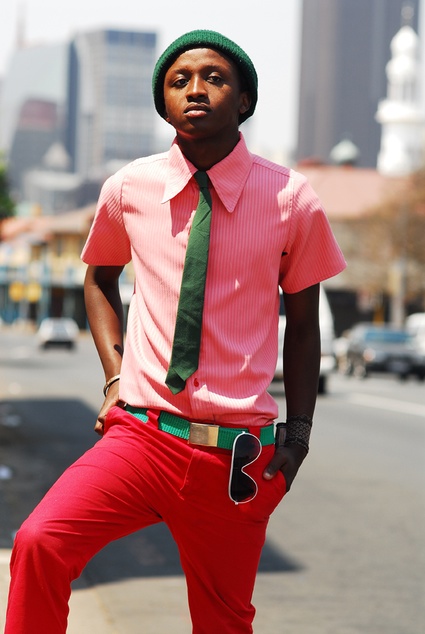 Nontsikelelo Veleko, Kepi, 2006
Nontsikelelo Veleko, Kepi, 2006
Nontsikelelo Veleko explores the fashion-sense of South Africa’s ‘born free’ generation that has grown up after the end of Apartheid.
The Guardian has an audio slideshow. The Independent has a slideshow of the David Goldblatt solo show at V&A.
Figures & Fictions: Contemporary South African Photography remains open at The Victoria and Albert Museum until 17th July 2011.
Related stories: Permanent Error, In South African prisons, Pieter Hugo’s Nollywood, Avenue Patrice Lumumba, Images of the Belgian Congo, Book review – The Cruel Radiance: Photography and Political Violence.
